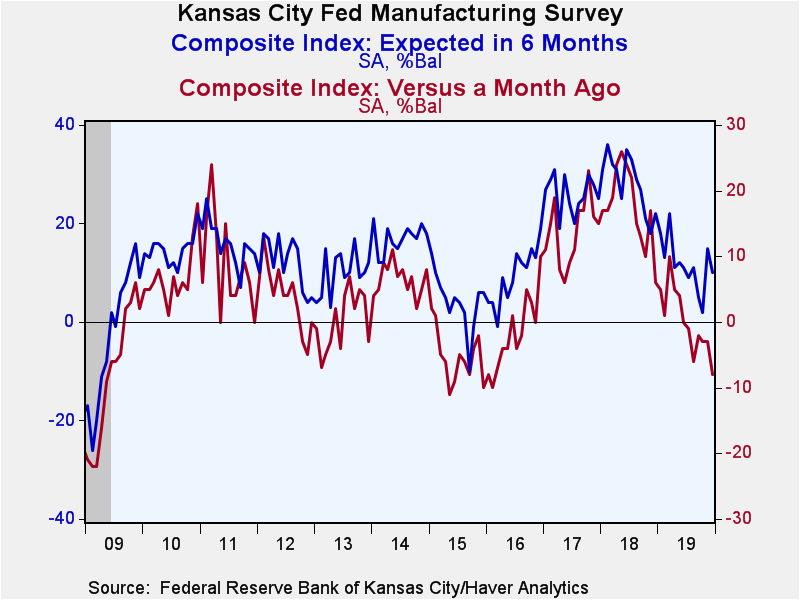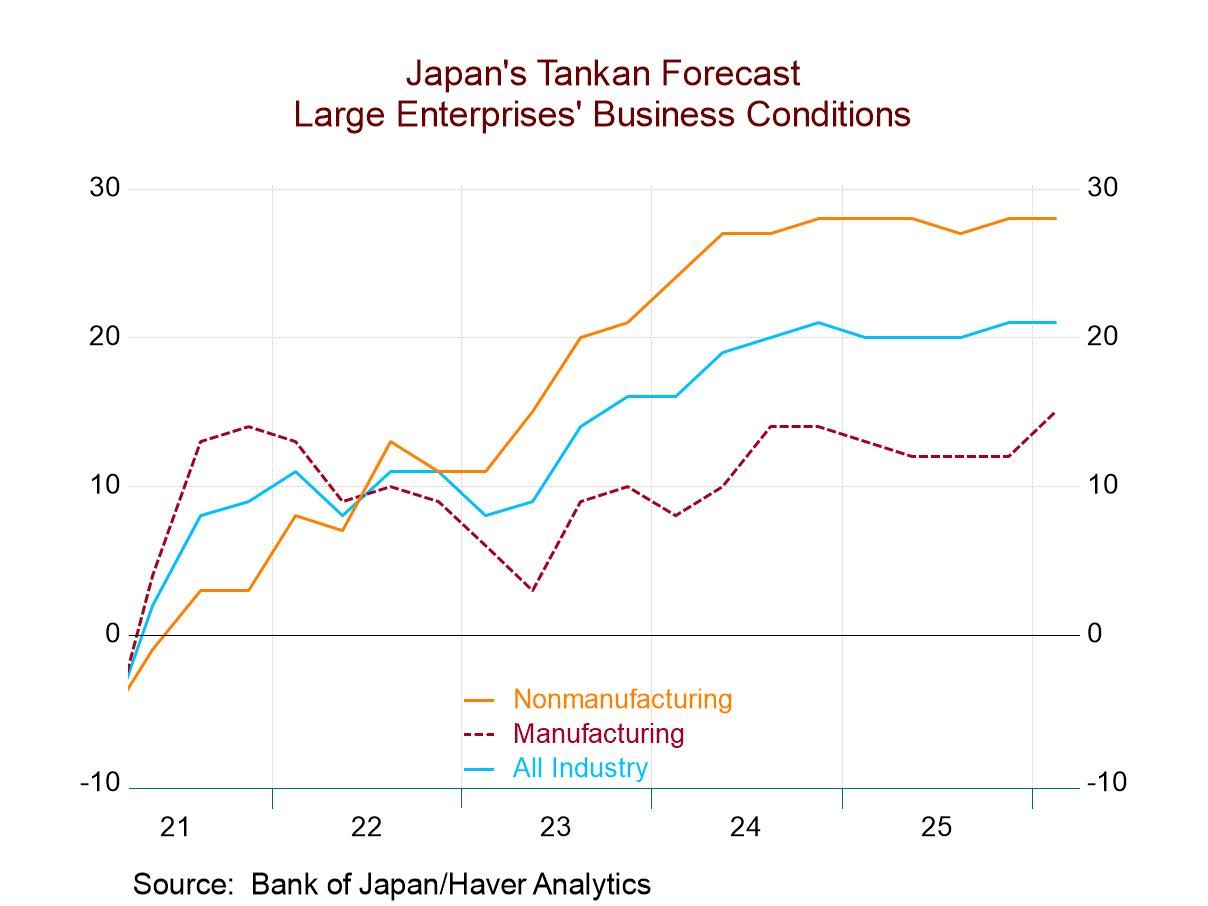 Global| Dec 20 2019
Global| Dec 20 2019Kansas City Fed Factory Index Recedes Further at Year-end
by:Sandy Batten
|in:Economy in Brief
Summary
The Federal Reserve Bank of Kansas City reported that its index of regional manufacturing business activity moved further below zero in December where it has been for the past six months, indicating further deterioration in [...]
The Federal Reserve Bank of Kansas City reported that its index of regional manufacturing business activity moved further below zero in December where it has been for the past six months, indicating further deterioration in manufacturing activity in the 10th Federal Reserve District. In December, the headline diffusion index fell to -8, its lowest reading since February 2016, from -3 in November. Negative readings indicate declining overall manufacturing activity. Over the past year and a half, the index has generally fallen from its most recent high of 26 reached in May 2018. The lethargy in current activity has begun to spread to expectations; while the index of expectations six months in the future remained positive, it fell to 10 in December from 15 in November.
The ISM-Adjusted Index fell significantly to 43.3 (NSA) in December, its lowest reading since December 2015, from 49.4 in November, indicating that the subindexes were as weak in December as was the headline index. This is the sixth consecutive month that this index has been below the 50 level that separates expansion from contraction.
Current condition components of the factory survey were uniformly weaker in December than in November. Of note, the shipments index plunged to -6 in December from +7 in November. This is the first time the shipments index has been below zero in four months The new orders diffusion index plummeted to -16 from -3. The employment index edged down to -10 from -9 with the average workweek index also slipping to -7 from -6, its second consecutive month below zero. And production declined to -7 from -5.
Finished product pricing power also appears to be ebbing as the index of finished goods prices fell to -2 in December, its first trip below zero in the past four months, from 5 in November. In contrast, the prices paid for raw materials index rose to 16 in December, its highest reading since February, from 14 in November.
The deterioration in the overall expectations index reflected meaningfully lower expectations for shipments (10 in December versus 25), orders (16 in December versus 28), and production (12 in December versus 25). Expectations for future employment, in contrast, rose to 13 in December from 4. However, capital expenditure expectations receded to 10 in December following an outsized jump to 14 in November. Still, expectations measures generally remained positive, in contrast to the generally negative readings on current conditions.
The expected finished goods price index held steady for the third consecutive month at 16 but remained well below the recent high of 51 reached in February 2018. The expected raw materials price figure rose for the second consecutive month to a five-month high.
The diffusion indexes are calculated as the percentage of total respondents reporting increases minus the percentage reporting declines. The December survey included 93 responses from plants in Colorado, Kansas, Nebraska, Oklahoma, Wyoming and northern New Mexico and was conducted in the period from December 11-16, 2019. Data for the Kansas City Fed Survey can be found in Haver's SURVEYS database.
Riders on the Storm from the Federal Reserve Bank of San Francisco can be found here.
| Kansas City Federal Reserve Manufacturing Survey (SA) | Dec | Nov | Oct | Dec '18 | 2019 | 2018 | 2017 |
|---|---|---|---|---|---|---|---|
| Conditions Versus One Month Ago (% Balance) | -8.0 | -3.0 | -3.0 | 6.0 | 0.0 | 18.0 | 14.0 |
| ISM-Adjusted Composite Index (NSA) | 43.4 | 49.4 | 48.5 | 51.5 | 50.0 | 58.9 | 56.7 |
| New Orders Volume | -16.0 | -3.0 | -13.0 | 7.0 | -3.0 | 17.0 | 17.0 |
| Number of Employees | -10.0 | -9.0 | -6.0 | 10.0 | -1.0 | 17.0 | 15.0 |
| Production | -7.0 | -5.0 | 8.0 | -13.0 | 2.0 | 18.0 | 17.0 |
| Prices Received for Finished Product | -2.0 | 5.0 | 4.0 | 8.0 | 7.0 | 22.0 | 7.0 |
| Expected Conditions in Six Months | 10.0 | 15.0 | 2.0 | 22.0 | 12.0 | 28.0 | 26.0 |
| New Orders Volume | 16.0 | 28.0 | 11.0 | 23.0 | 17.0 | 35.0 | 35.0 |
| Number of Employees | 13.0 | 4.0 | 4.0 | 37.0 | 15.0 | 33.0 | 31.0 |
| Production | 12.0 | 25.0 | 2.0 | 24.0 | 19.0 | 40.0 | 40.0 |
| Prices Received for Finished Product | 16.0 | 16.0 | 16.0 | 41.0 | 26.0 | 42.0 | 27.0 |
Sandy Batten
AuthorMore in Author Profile »Sandy Batten has more than 30 years of experience analyzing industrial economies and financial markets and a wide range of experience across the financial services sector, government, and academia. Before joining Haver Analytics, Sandy was a Vice President and Senior Economist at Citibank; Senior Credit Market Analyst at CDC Investment Management, Managing Director at Bear Stearns, and Executive Director at JPMorgan. In 2008, Sandy was named the most accurate US forecaster by the National Association for Business Economics. He is a member of the New York Forecasters Club, NABE, and the American Economic Association. Prior to his time in the financial services sector, Sandy was a Research Officer at the Federal Reserve Bank of St. Louis, Senior Staff Economist on the President’s Council of Economic Advisors, Deputy Assistant Secretary for Economic Policy at the US Treasury, and Economist at the International Monetary Fund. Sandy has taught economics at St. Louis University, Denison University, and Muskingun College. He has published numerous peer-reviewed articles in a wide range of academic publications. He has a B.A. in economics from the University of Richmond and a M.A. and Ph.D. in economics from The Ohio State University.










